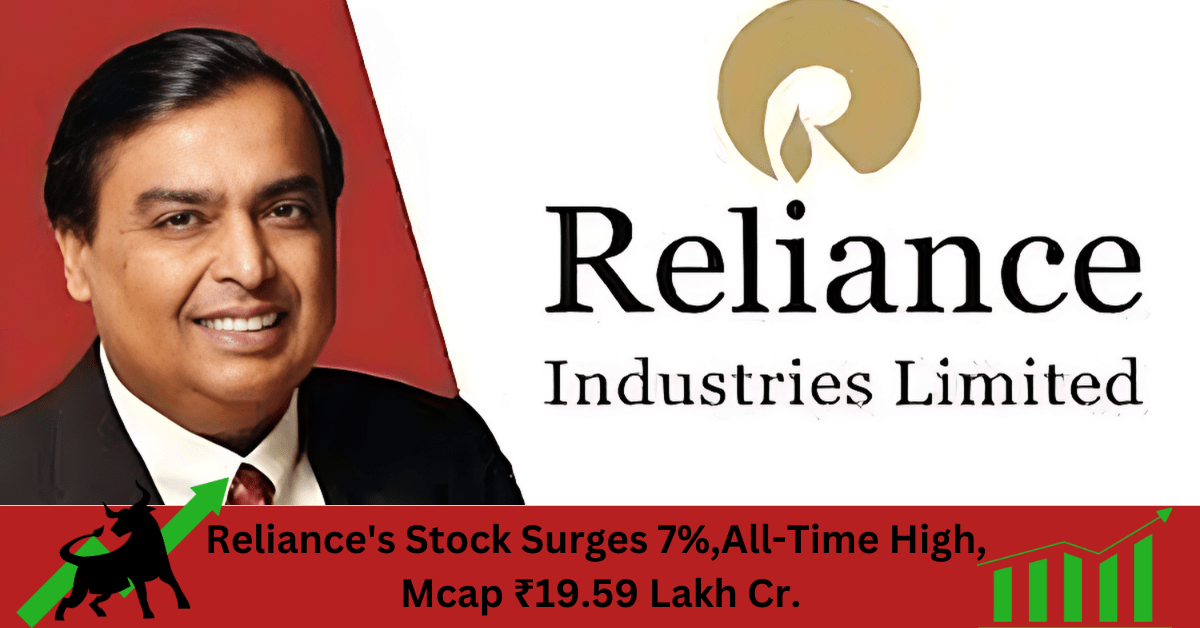In Monday’s trading, shares of Reliance Industries Ltd. (RIL), the most valuable company in India based on market capitalization (m-cap), surged 7% to reach a record high. The oil-to-telecom giant actually increased its market capitalization intraday by Rs 1.20 lakh crore, reaching Rs 19,53,253.43 crore today from Rs 18,33,737.60 crore on Thursday. The increase in RIL shares was accompanied by a high turnover rate; so far in the day, Rs 2,832.59 crore worth of RIL shares have changed hands on the NSE.
RIL’s stock surged 6.99% on the BSE, reaching a peak of Rs 2,900. The BSE Oil & Gas index rose 4.8% intraday thanks to Reliance Industries and ONGC, and the index’s technical charts turned positive.
Nomura India’s top pick in the oil and gas industry is Reliance Industries. The brokerage stated that all segments of RIL’s outlook are still positive. According to the report, the growth of consumer businesses is still strong. Jio’s growth is supported by tariff hikes following the central elections, while Reliance Retail’s is supported by store expansions, strong growth in digital and new commerce, and operating leverage.
In addition, the foreign brokerage stated in a recent note that upstream has significantly increased and will maintain its strong performance in FY25, and that the O2C segment will benefit from strong global oil demand growth of over 1.2 million barrels per day in 2024.
As per Nomura India, RIL is expected to reap additional benefits from its strong free cash flow generation of Rs 30,000 crore in FY25F, as well as a decrease in capital expenditure to approximately Rs 1.25 lakh crore and debt to Rs 2.7 lakh crore.
The oil and gas industry has surged into positive territory following the most recent breakout in the index. The Nifty Oil and Gas index recently saw consolidation end with an upside breakout, suggesting heightened optimism in the market that might last in the upcoming days. Thus, in the near run, the abrupt increase in energy stocks may help support the headline index, according to Rupak De, Senior Technical Analyst at LKP Securities.
Can Reliance Become The India’s First USD1 Trillion Company?
India is expected to have its first $1 trillion company by 2032 if the country’s GDP growth rate accelerates to around 9% from the current 7%, domestic brokerage firm ICICI Securities said on Monday.
Reliance Industries Limited (RIL), HDFC Bank, and Bajaj Finance are the three main competitors for this exclusive club. With a market capitalization (Mcap) of approximately Rs 19 lakh crore (roughly $230 billion), Reliance Industries, led by Mukesh Ambani, is currently the largest listed company in India.
If RIL’s long-term profit growth trajectory increases to 21%, its market capitalization is expected to reach $1 trillion by 2032.
While Bajaj Finance must continue to grow at its previous rate of 35 percent to 40 percent over the next ten years, HDFC Bank must accelerate its profit growth trajectory to 25.5% from its historical profit growth trajectory of roughly 20% in order to reach the $1 trillion mark by 2032.
The faster economic growth will be a major factor in these companies’ increased profit margins. The brokerage firm is making the assumption that the real GDP growth rate will gradually pick up speed, rising from the predicted 7% in the current fiscal year to 9%. It also assumes that corporate profitability, as expressed by the ratio of “profit after tax” to GDP, will rise from its current 5–6% to its previous peak of 7%.
Based on their hurdle rate (the percentage of growth in market capitalization required going forward), which should be close to their historical long-term profit CAGR track record, the brokerage firm selected RIL, HDFC Bank, and Bajaj Finance as likely companies to reach the coveted milestone.
“Market valuations are not expected to increase from their current levels, but if corporate profits expand at a faster rate than the GDP, Mcap/GDP will reach 160% without an increase in P/E (price-earnings ratio),” the statement stated.






I don’t think the title of your article matches the content lol. Just kidding, mainly because I had some doubts after reading the article.